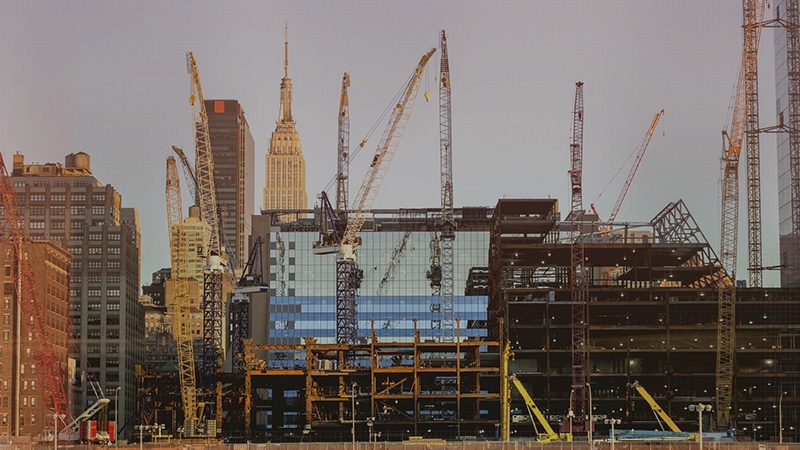
Data is key to solving the inventory crisis, Enstoa’s CEO says
Enstoa’s acquisition of designtech creates new efficiencies in evaluating development projects
When pundits discuss the booming U.S. economy, there is one sector that is often considered a problem child — construction and development.
Due to a variety of factors — including workforce shortages, lack of capital and failure to integrate technology into their processes — developers often seem to struggle to meet the needs of the market on both the residential and commercial building sides.
I sat down with Jordan Cram, CEO of Enstoa, an NYC-based systems integrator for capital projects worldwide, to discuss his company’s acquisition of designtech, a UK company that specializes in the development of technologies to help produce, manage and integrate design data.
Can you tell me about how Enstoa has operated within the real estate space in general and in North American markets in particular?
Enstoa helps those in the business of acquiring properties, building or disposing of assets to digitize their business by creating digital transformation visions and execute on those visions.
The construction industry is lagging far behind in efficiency and productivity, and we believe digital business solutions [are] paramount in correcting that.
We work with developers’ strategy and execution teams to identify areas where digital solutions and data can unlock value in portfolio planning, design, construction, through property management and asset management to help those who are operating and maintaining facilities.
How does the acquisition of designtech change Enstoa’s ability to serve clients?
The technology created by designtech is applicable across the sectors in which we work, especially in terms of real estate and developers. With designtech, we can shortcut the planning process by months by replacing paper-based ways of evaluating properties and projects.
We’ve got a solution that within 10-20 seconds can generate a profile scenario for a strategic planning committee to consider. Architects or master planners take about a month to do the same thing.
It’s the data that is available in design packages plus the machine learning that gets applied to it — that’s the special sauce — in addition to the industry know-how that we bring because we understand the underlying data and the data mindset as well as being well-versed in AI and machine learning.
Put it all together, and it is groundbreaking.
In the handover from construction to property management — and here our industry has a huge problem with underutilization of data collected during design and construction — millions and millions of dollars are lost. Designtech’s capability allows us to deliver data on the full lifecycle of that asset.
Many markets are facing low inventory and lagging rates of new construction, and the industry itself has a variety of challenges to deal with. What do you see as the biggest challenges that technology can ameliorate?
I think the root of the issue is in the boardroom. Organizations have capital, and they need a return on their capital. They can buy shares back, or they can invest in funds … or they can build assets.
The work we do is in the third category.
Boards see that as very high risk, so even though the returns are significantly greater, they’re nervous because they don’t have the tools to oversee the governance of construction. Instead, they choose to put the capital into other things.
By giving executives, managers and boards tools and data to make informed decisions — across one project or a whole portfolio of projects — we can give reassurance that increases capital flow to new projects.
There are also downstream things like labor productivity that we can help with, but if the projects don’t start, those things are immaterial.
What do you foresee as a having the biggest impact in the near term on real estate, either from the perspective of the building process, materials or design?
There is demand on one side and available capital on the other. There is more capital sitting around than there ever has been.
There is high demand for real estate and infrastructure in every country in the world. But they are not moving toward each other.
Real estate doesn’t have the same challenges that others have with regulatory issues. Getting the money moving and providing reassurance to investors brings those stakeholders together and connects capital supply with real estate demand.
The impact of climate change seems to be emerging as a major factor in long-term planning for municipalities as well as builders and developers. How can the kind of service you provide help stakeholders plan for changing weather patterns and conditions?
It can generate scenarios — not just two or three, which is the limit of the human brain — but on a much larger scale for a single plot or an entire county. That analysis applies machines which can generate hundreds or thousands of scenarios to allow people to understand the impacts of the different drivers.
I don’t think anyone should be in those kinds of processes without a lot of data and machine learning and algorithms because even the most valid experience expert can’t get the kind of scale that these tools can give.
People are beginning to ask for that information. I think there’s a lot of people — media and academics — who have been working hard to get the word out and change paradigms in terms of leveraging these technologies. Breaking the logjam is difficult, but I see progress.
Link to the original article here.
Published in inman on August 08, 2018
Enstoa’s acquisition of designtech creates new efficiencies in evaluating development projects
When pundits discuss the booming U.S. economy, there is one sector that is often considered a problem child — construction and development.
Due to a variety of factors — including workforce shortages, lack of capital and failure to integrate technology into their processes — developers often seem to struggle to meet the needs of the market on both the residential and commercial building sides.
I sat down with Jordan Cram, CEO of Enstoa, an NYC-based systems integrator for capital projects worldwide, to discuss his company’s acquisition of designtech, a UK company that specializes in the development of technologies to help produce, manage and integrate design data.
Can you tell me about how Enstoa has operated within the real estate space in general and in North American markets in particular?
Enstoa helps those in the business of acquiring properties, building or disposing of assets to digitize their business by creating digital transformation visions and execute on those visions.
The construction industry is lagging far behind in efficiency and productivity, and we believe digital business solutions [are] paramount in correcting that.
We work with developers’ strategy and execution teams to identify areas where digital solutions and data can unlock value in portfolio planning, design, construction, through property management and asset management to help those who are operating and maintaining facilities.
How does the acquisition of designtech change Enstoa’s ability to serve clients?
The technology created by designtech is applicable across the sectors in which we work, especially in terms of real estate and developers. With designtech, we can shortcut the planning process by months by replacing paper-based ways of evaluating properties and projects.
We’ve got a solution that within 10-20 seconds can generate a profile scenario for a strategic planning committee to consider. Architects or master planners take about a month to do the same thing.
It’s the data that is available in design packages plus the machine learning that gets applied to it — that’s the special sauce — in addition to the industry know-how that we bring because we understand the underlying data and the data mindset as well as being well-versed in AI and machine learning.
Put it all together, and it is groundbreaking.
In the handover from construction to property management — and here our industry has a huge problem with underutilization of data collected during design and construction — millions and millions of dollars are lost. Designtech’s capability allows us to deliver data on the full lifecycle of that asset.
Many markets are facing low inventory and lagging rates of new construction, and the industry itself has a variety of challenges to deal with. What do you see as the biggest challenges that technology can ameliorate?
I think the root of the issue is in the boardroom. Organizations have capital, and they need a return on their capital. They can buy shares back, or they can invest in funds … or they can build assets.
The work we do is in the third category.
Boards see that as very high risk, so even though the returns are significantly greater, they’re nervous because they don’t have the tools to oversee the governance of construction. Instead, they choose to put the capital into other things.
By giving executives, managers and boards tools and data to make informed decisions — across one project or a whole portfolio of projects — we can give reassurance that increases capital flow to new projects.
There are also downstream things like labor productivity that we can help with, but if the projects don’t start, those things are immaterial.
What do you foresee as a having the biggest impact in the near term on real estate, either from the perspective of the building process, materials or design?
There is demand on one side and available capital on the other. There is more capital sitting around than there ever has been.
There is high demand for real estate and infrastructure in every country in the world. But they are not moving toward each other.
Real estate doesn’t have the same challenges that others have with regulatory issues. Getting the money moving and providing reassurance to investors brings those stakeholders together and connects capital supply with real estate demand.
The impact of climate change seems to be emerging as a major factor in long-term planning for municipalities as well as builders and developers. How can the kind of service you provide help stakeholders plan for changing weather patterns and conditions?
It can generate scenarios — not just two or three, which is the limit of the human brain — but on a much larger scale for a single plot or an entire county. That analysis applies machines which can generate hundreds or thousands of scenarios to allow people to understand the impacts of the different drivers.
I don’t think anyone should be in those kinds of processes without a lot of data and machine learning and algorithms because even the most valid experience expert can’t get the kind of scale that these tools can give.
People are beginning to ask for that information. I think there’s a lot of people — media and academics — who have been working hard to get the word out and change paradigms in terms of leveraging these technologies. Breaking the logjam is difficult, but I see progress.
Link to the original article here.
Published in inman on August 08, 2018




